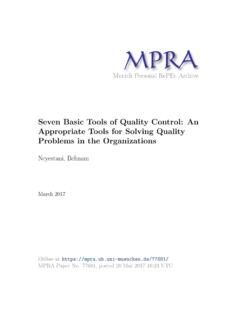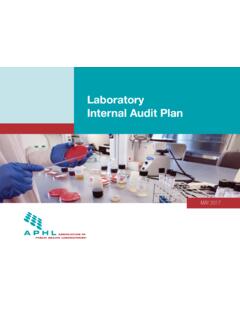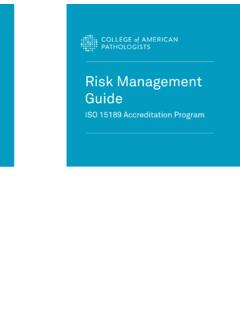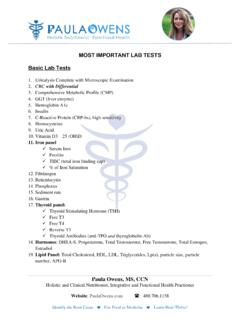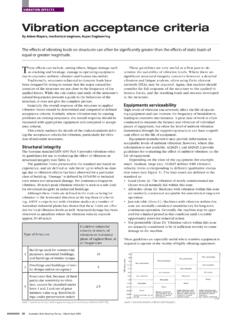Transcription of Lead in Soil
1 ENVIRONMENTAL PROTECTION AGENCY, REGION III. Lead in Soil August 2020 Lead naturally occurs in soil at low levels. Hundreds of years of human activities have contributed to increased levels of lead in soil, especially in and around urban areas and near older homes. Lead does not breakdown over time, so lead deposited in the past can still be a problem today. Lead in soil can contribute to overall environmental lead exposure. Other sources of environmental lead exposure include chipping lead-based paint, lead contaminated dust, and lead in drinking water.
2 Exposure to lead is a health concern1, especially for young children and pregnant women. Lead can affect almost every organ and system in your body. The nervous system is the main target for lead poisoning in children and adults. Exposure to lead can cause developmental effects in children, including but not limited to reduced IQ and attention span, hyperactivity, impaired growth, and learning disability. Sources of Lead in Soil Higher levels of lead are found in soil: Near roadways as a result of air emissions from vehicles that used leaded gasoline Near the perimeter of buildings that used lead paint that deteriorated as chips and dusts, or from past renovation activities Lead may also be found at high levels in soil near toxic waste sites and other areas close to industrial sites that release lead into the environment.
3 Exposure to Lead in Soil Children and adults can be exposed to lead in soil through: Playing in bare soil Gardening Eating fruits and vegetables grown in contaminated soil Ingesting soil Touching hands to mouths (typical in young children). Testing Soil Soil can be tested for lead in several ways. The primary approach is to send samples to a laboratory that can identify the concentration of lead in the soil. Most laboratories associated with State university agricultural departments and agricultural extension offices offer soil testing for lead at cost.
4 You may choose to contact a laboratory recognized under EPA's National Lead Laboratory Accreditation Program2 (NLLAP) for lead paint chip, dust or soil sample analysis . You may also hear of an opportunity to have your soil screened for lead at soilSHOP 3 events where organizers use an instrument called an x-ray fluorescence (XRF) meter to quickly estimate the concentration of lead in the soil sample. A certified lead risk assessor can also identify lead hazards in soil. For help finding a lead risk assessor, call the National Lead Information Center at 1-800-424-LEAD (5323).
5 Interpreting soil lead results can be challenging. There is no single threshold that defines acceptable levels of lead in soil. State and federal regulatory and guidance values may only address specific situations and are mostly focused on cleaning up industrial properties. 1. 2. 3. ENVIRONMENTAL PROTECTION AGENCY, REGION III. Recommended soil lead level limits for growing food in gardens From Kansas State University Agricultural Experiment Station and Cooperative Extension Service, and adopted by the Penn State Cooperative Extension Service Depending on where you live, it is common to find lead levels in your yard or garden at or above guidance values.
6 This is generally not cause for alarm as there are ways to reduce exposure to lead in soil. EPA defines a soil lead hazard as bare soil on residential real property or on the property of a child-occupied facility that contains total lead equal to or exceeding 400 parts per million (ppm) in a play area, or an average of 1,200 parts per million of bare soil in the rest of the yard based on soil samples. States may have their own values. You may decide to take a cautious approach if children routinely come in contact with soils that contain (or are suspected of containing).
7 Elevated levels of lead. It is important to keep in mind that the results for one or two samples collected from your yard do not necessarily represent soil levels throughout the yard. Soil is highly variable and lead concentrations can be quite different even in samples collected from one or two feet of each other. If you are concerned about your soil lead results, consider contacting your cooperative extension service, public health department, or gardening organization to discuss the issue and next steps.
8 Note that testing results identifying a soil-lead hazard at pre-1978 properties are records that must be retained and disclosed to future tenants/buyers in accordance with the Lead Disclosure Rule4. Recommendations to Reduce Contamination and Exposure to Lead in Soil It is important to research the prior usage of your property and the surrounding area5, especially before planning a community garden or recreational area. There are numerous options to reduce exposure to lead in soil, including: Cover contaminated soil with a thick layer of clean soil, vegetation, mulch or other materials.
9 Limit access to more contaminated areas. Keep soil outdoors by using doormats, taking off shoes, and other lead-safe cleaning practices. Reduce exposure from pets that go outside by maintaining proper pet hygiene. Wash produce well, peel root crops, and discard outer leaves of leafy vegetables. Consider growing ornamental plants instead of food crops. Wear gloves or wash hands and other exposed skin areas after coming into contact with soil. Wash clothes after coming in contact with soil/dust separately from other clothes.
10 Prevent children from playing in bare soil and watch children carefully to prevent them from eating soil. Wash toys and pacifiers frequently. Avoid growing produce directly adjacent to buildings, where lead levels are likely highest. Build raised beds with clean soil to grow food crops in more contaminated areas. Hire lead abatement contractors to remove or permanently cover the soil. 4. 5.










